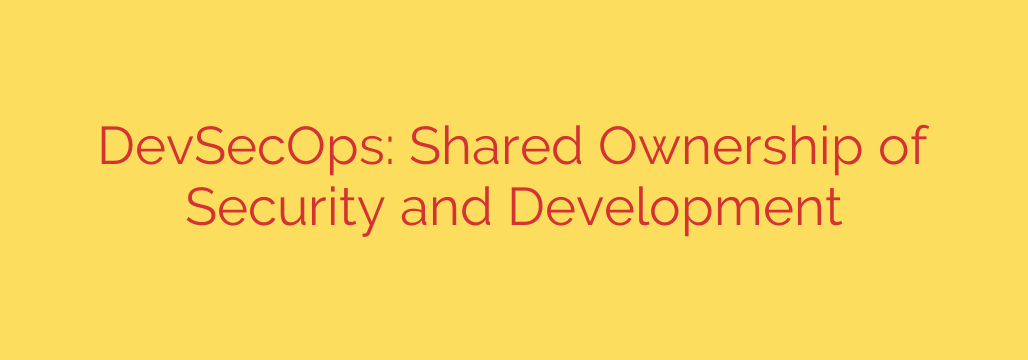
DevSecOps: Building Security Directly into Your Development Lifecycle
In the fast-paced world of modern software development, traditional security models are no longer sufficient. The old approach—where a separate security team performs checks at the end of the development cycle—creates bottlenecks, slows down releases, and treats security as an afterthought. This is where DevSecOps comes in, offering a transformative approach that integrates security into every stage of the software development lifecycle.
DevSecOps isn’t just a new buzzword; it’s a fundamental shift in culture, process, and tooling. It represents the evolution of DevOps principles to include security as a shared responsibility for everyone involved in building software.
The Problem with Traditional “Gatekeeper” Security
For years, security teams have acted as gatekeepers. Developers would write code, pass it through QA, and then hand it over to the security team for a final penetration test or vulnerability scan right before deployment. If issues were found—and they often were—the code was sent back to the developers, causing significant delays and friction.
This model is fundamentally incompatible with agile and DevOps methodologies, which rely on speed, iteration, and continuous delivery. In this environment, a final security gate is not just a bottleneck; it’s a roadblock.
What is DevSecOps? A New Philosophy for Secure Development
DevSecOps is a cultural and practical shift that automates the integration of security at every phase of the software development lifecycle, from initial design to production monitoring.
The core principle of DevSecOps is that security is a shared responsibility. Instead of one team owning security, everyone—from developers and operations engineers to quality assurance professionals—is accountable for building secure applications. This is often referred to as “shifting security to the left,” which means moving security practices earlier in the development process.
When security is baked in from the start, vulnerabilities are caught and remediated when they are cheapest and easiest to fix: during development.
The Key Pillars of a Strong DevSecOps Culture
Successfully implementing DevSecOps requires more than just buying new tools. It depends on fostering a culture built on several key pillars:
- Automation is Non-Negotiable: Manual security reviews cannot keep pace with modern development. DevSecOps relies heavily on automating security checks within the Continuous Integration/Continuous Delivery (CI/CD) pipeline. This includes automated code analysis (SAST), dynamic application testing (DAST), and software composition analysis (SCA) to check for vulnerabilities in open-source libraries.
- Embracing a Culture of Shared Ownership: In a DevSecOps environment, developers are empowered to become the first line of defense. They are given the training and tools needed to write secure code from the outset. Security teams transform from gatekeepers into expert consultants who enable developers to make secure decisions.
- Continuous Feedback and Improvement: When an automated scan finds a vulnerability, the feedback is delivered directly to the developer within their existing workflow, just like a standard bug report. This creates a tight feedback loop that allows for immediate remediation and continuous learning.
The Tangible Benefits of Adopting DevSecOps
Organizations that successfully transition to a DevSecOps model realize significant advantages that go beyond just better security.
- Accelerated and Secure Delivery: By eliminating the final security bottleneck, teams can release software faster and more frequently without compromising on security.
- Reduced Costs and Remediation Time: Finding and fixing a security flaw during the coding phase is exponentially cheaper than fixing it once the application is in production.
- Enhanced Collaboration and Reduced Friction: When development, security, and operations teams work together with a common goal, departmental silos break down, leading to improved communication and morale.
- Improved Security Posture and Compliance: Continuously testing and monitoring for threats results in more resilient applications and makes it easier to meet and demonstrate compliance with regulatory standards.
Practical Steps to Implement DevSecOps
Transitioning to DevSecOps is a journey, not an overnight switch. Here are some actionable steps to get started:
- Start with Education and Training: Provide your development teams with foundational secure coding training. When developers understand common vulnerabilities like the OWASP Top 10, they can actively avoid them.
- Automate Security in the CI/CD Pipeline: Integrate a Static Application Security Testing (SAST) tool to scan code for vulnerabilities with every commit. This provides immediate feedback and establishes a baseline for security.
- Secure Your Software Supply Chain: Use Software Composition Analysis (SCA) tools to automatically scan your dependencies and open-source libraries for known vulnerabilities. This is critical, as a huge portion of modern applications is built on third-party code.
- Implement Infrastructure as Code (IaC) Security: Scan your IaC scripts (like Terraform or CloudFormation) for misconfigurations before they are ever deployed. This prevents common cloud security issues from occurring.
- Foster Collaboration, Not Blame: Create a culture where security findings are treated as opportunities for learning, not as a reason to assign blame. Encourage open communication between developers and security experts.
DevSecOps is More Than Tools—It’s a Mindset
Ultimately, DevSecOps is about fundamentally changing how an organization thinks about security. It moves security from an isolated function performed by a few to an integrated responsibility shared by all. By embedding security into the DNA of your development process, you can build better, safer software faster and more efficiently than ever before, creating a solid foundation for innovation and growth in an increasingly complex digital world.
Source: https://www.helpnetsecurity.com/2025/07/18/galal-ibrahim-maghola-devsecops-practices-tips/








